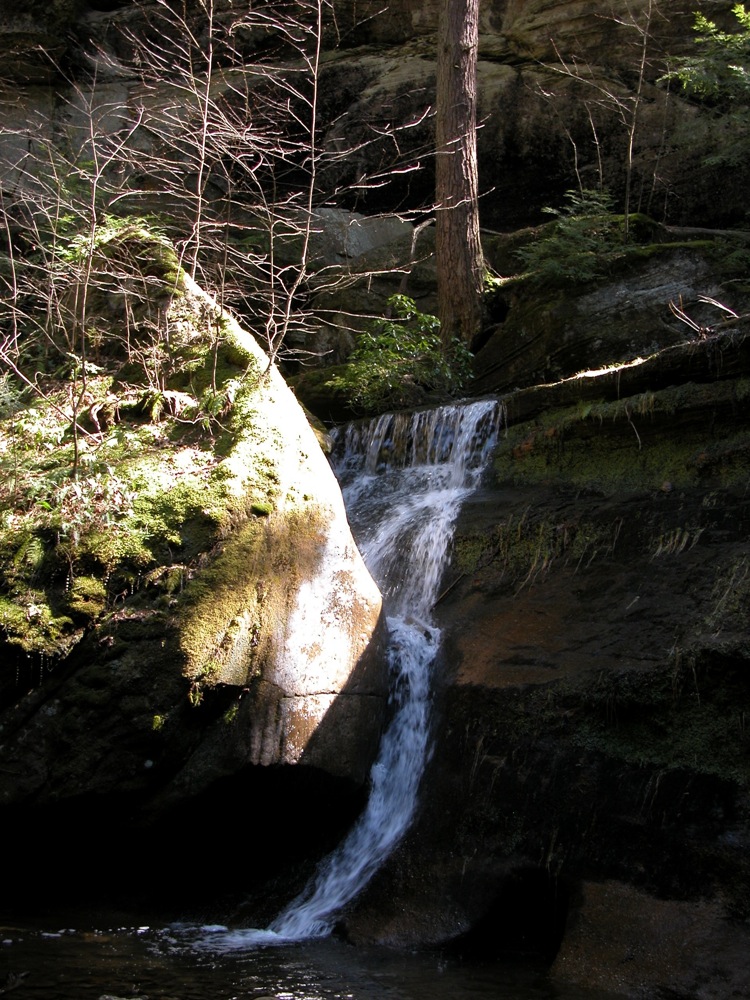

The watershed which a waterfall occurs within, if it is specified, will be based on the ultimate distributary watercourse to the ocean. For more information on our waterfall form classifications, see the Help page. Additional deliniation is then applied depending on characteristics such as the breadth of the falls, whether it splits into two or more channels, whether it falls in multiple successive drops, etc. There are five primary Categories of falls in this system: Plunge, Horsetail, Steep Cascades, Shallow Cascades, and Rapids. While plumb uses eight distnct forms, we wanted further granularity and opted to break down the hierarchy twofold: first based on the overall pitch of the waterfall, and then based on what shape the fall takes as it makes its descent. The system of classification of waterfall forms we use is a heavily modified derivative of the classifications outlined by Greg Plumb in his "Waterfall Lover's Guide to the Pacific Northwest" books. Waterfalls with a longer Run will usually either be less steep, often cascading type waterfalls, or will feature multiple steps separated by shorter stretches of a more gradual gradient streambed. This figure is not often easy to establish with a high degree of precision and as such will often be estimated. The Run of a waterfall is a measurement representing the total linear distance on the ground between the top and bottom of a waterfall. Similarly, a waterfall with two drops separated by a pool, one with a true free-falling drop, and one with a Horsetail type fall will average the two, so while the Plunging drop has a Pitch of 90 degrees, if the Horsetail drop has a Pitch of 45 degrees, the total Pitch will be roughly 67 degrees. As an example, a waterfall which features two truly free-falling leaps separated by several dozen yards of flat stream will have a Pitch of 90 degrees. Pools or stretches of level stream in between two or more successive drops of the falls will not factor in this figure. The Pitch figure only takes into account sections of stream which are actively falling. The Pitch of a waterfall is an estimated - often very roughly - measure of the average slope or steepness of a waterfall. Like the Average Width measurement, this measurement will take into account the difference in width at the top and bottom of the waterfall as much as possible, but will often be made based on the width of the crest of th falls alone. For smaller waterfalls, this figure will generally not differ much from the Average Width measurement, but for broader waterfalls - especially those that feature a crest that isn't constricted - this figure can at times be consideraby larger. Maximum Width represents a hypothetical measurement of roughly how wide a waterfall could get during peak streamflow or flood conditions. We often utilize Google Earth to measure the width (where imagery is of sufficient quality and resolution to allow it. Often this number will be approximated because of a lack of approachability to many waterfalls. The Average Width of the waterfall represents the breadth of the waterfall from bank to bank under typical flow conditions, or if the waterfall has been Cataloged, under the conditions which it was most thoroughly surveyed. Stretches of interstitial stream in between two or more distinct drops of a single waterfall are NOT considered to be distinct drops of the waterfall unless the section of stream in question would otherwise qualify as a waterfall were it to be isolated. The Number of Drops in a waterfall is a tally of the total number of distinct drops which make up the waterfall. Waterfalls with only one drop will have the total height of the waterfall repeated here. The Tallest Drop figure represents the height of the largest single drop within a multi-stepped waterfall. Waterfalls with only one drop will of have the height of only the single drop listed here. Stream between two tiers of a waterfall is counted in its overall height regardless of whether or not that section of the stream would be legitimately considered a waterfall on its own right, were it to be isolated. The Total Height listed for the waterfall represents the difference in elevation from the top of the uppermost drop, to the bottom of the lowermost drop of the waterfall, including all stretches of interstitial stream in between.

This information may be changed at any given time to ensure accuracy.

While we try to ensure this information is as accurate as possible, sometimes it will prove necessary to either estimate or flat out guess at certain characteristics where either enough information isn't readily available, is not known, or we were not able to confirm a given trait upon surveying. The information presented in this table is meant to help identify and clarify the physical aspects of the waterfall for comparative purposes.


 0 kommentar(er)
0 kommentar(er)
